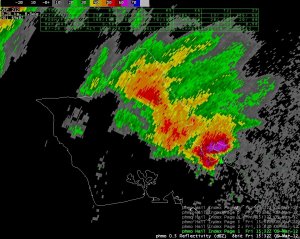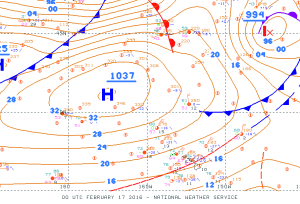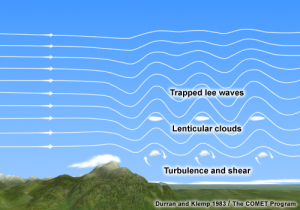One of the reasons I like staffing a NOAA/National Weather Service booth at aviation-related events (such as the recent Hawaii Aviation Day at the Hawaii State Capitol) is because of the questions that pilots ask. If one person asks a question, chances are there are others out there wondering the same thing. This article will highlight a few sources of weather information available on the NWS Honolulu website that may be useful but not well known, and also introduce an initiative that’s designed to improve communication between our office and community groups interested in improving weather safety and preparedness.
Tag Archives: aviation
Winds Aloft: Sources of Information
The Summer 2016 newsletter article on trade wind inversions referenced the weather balloons we launch twice a day from Lihue and Hilo, which measure winds aloft in addition to temperature and moisture. In this article we’ll look at two additional sources of wind information: radar wind observations and the automated winds aloft forecasts.
Trade Wind Inversions
In the Winter 2014 newsletter, I talked about trade winds and briefly touched on trade wind inversions. Inversions have a big impact on the weather we see in Hawaii, and knowing more about them may be of interest to pilots.
What Is An Inversion?
Temperature normally decreases with height in the atmosphere. (The higher you go, the colder it gets.) For dry air, the temperature drops about 5.4°F for every 1000 feet, or about 9.8°C for every kilometer. An inversion is a layer where the temperature either remains the same or increases with height. It is the result of an outside force, such as a change in airmass along a front where warm air overruns cold air. The typical driving force we see in Hawaii associated with the trade winds is due to sinking air associated with high pressure systems.
Low Level Wind Shear
On February 16th, 2016, a 1037mb high northwest of the state brought strong and gusty northeast trade winds to the islands. We received many reports of low-level wind shear, some which we were due to non-convective wind shear and some of which were due to convective mixing and gusty winds. What are the different types of wind shear, when is wind shear included in a TAF, and what can you do to mitigate the risk from it when you fly?
When Weather Radar Measures More Than Weather
Note: I originally wrote this article for the General Aviation Council of Hawaii Spring 2015 newsletter. Hopefully you will find it interesting and educational as well. –JB
(For more background on weather radar basics and an overview of the different radars in Hawaii, see the GACH newsletter from Fall 2012.)
Not everything you see on a weather radar image is necessarily a weather feature. Weather radars use a series of complex algorithms to filter out energy from non-meteorological returns. In general terms, if an object is stationary, then it’s most likely not weather-related. For example, a mountain will reflect a lot of energy back to the radar. Luckily, mountains don’t move (much), and the radar will identify and filter out these types of returns. However, no algorithm is perfect, and some returns make it into the final reflectivity product even though they’re not actually precipitation. Here are a few of the more common non-meteorological returns we see in Hawaii:
Trade Winds
Note: I originally wrote this article for the General Aviation Council of Hawaii Winter 2014 newsletter, hence the aviation focus. Hopefully you will find it interesting and educational as well. –JB
In the last article we discussed severe weather features such as tornadoes and water spouts. These weather phenomena are not common, especially in Hawaii. For the bulk of the year our weather is driven by the trade winds. In this article we’ll take a look at what drives the trades, how they affect our weather, and the types of impacts to aviation that we may see from them.
Rotating Columns of Air: Tornadoes, Waterspouts, Funnel Clouds and Dust Devils
Note: I originally wrote this article for the General Aviation Council of Hawaii Fall 2013 newsletter, following a particularly busy couple of weeks. Hopefully you will still find it interesting and educational. –JB
During a period of unsettled weather at the beginning of this month [October, 2013], National Weather Service spotters have reported water spouts, funnel clouds, and dust devils on many different days. We have also received a number of questions about the differences between these features and others, such as tornadoes. This is a good opportunity to review the differences between these features, and look at the hazards to aviation that they pose.
Low-Level Turbulence Climatology
Note: I originally wrote this article for the General Aviation Council of Hawaii Winter 2013 newsletter. The results weren’t quite what I expected, but still proved interesting. Instead of highlighting where turbulence occurs, the pilot reports instead highlighted areas where aircraft tend to fly (i.e., Oahu, mainly with reference to HNL or CKH). –JB
In the Winter 2012 newsletter, I talked about mechanical turbulence and mountain waves. Moderate turbulence is the most common reason for an AIRMET around the Main Hawaiian Islands. In the 12 year period from 2001 to 2012, an AIRMET for turbulence was in effect for at least a portion of the day for over half of the time. By contrast, an AIRMET for mountain obscuration/IFR conditions was in effect for less than a quarter of the time, and an AIRMET for icing was in effect for less than five percent of the time.
Even though turbulence is common, there is little specific information available as to where it occurs (other than “over and downwind of the mountains”). The National Weather Service in Honolulu will begin a project this summer to quantify where turbulence is most likely to be encountered. By taking pilot reports of turbulence and sorting them based on atmospheric stability and low-level wind fields, we will be able to map where turbulence occurs during different weather patterns.
Weather Radar in Hawaii
Note: I originally wrote this article for the General Aviation Council of Hawaii Fall 2012 newsletter. Had to make a couple tweaks to the dual-polarization section, since upgrades at all Hawaii radars were completed in 2013. –JB

Radar image of a supercell thunderstorm from March 9th, 2012. This storm brought large hail to Kailua and Kaneohe, including a record-setting hailstone that measured 4.25 inches long, and generated a tornado that damaged homes in Lanikai.
Weather radars are one of the most effective tools for detecting rainfall. This article includes information about weather radar in general, and about the specific radar sites we have in Hawaii.
Weather Radar Basics
The radar transmits an electromagnetic pulse, which reflects off objects in the atmosphere. (The objects could be anything, not just precipitation; one common problem around Hawaii is with sea spray being detected during windy days.) A small fraction of the energy is returned to the radar. The radar measures how much energy is reflected back, and how long it took to return. The energy is converted into reflectivity, and the time is converted into distance from the radar. Larger or more numerous objects return more energy, and result in a higher reflectivity.
Mountain Turbulence
Note: I originally wrote this article for the General Aviation Council of Hawaii Winter 2012 newsletter. Hopefully you will find it interesting and educational as well. –JB
Two common types of turbulence associated with mountains are mechanical turbulence and mountain waves. Mechanical turbulence is a result of an obstruction to the wind flow. Obstructions can range in size from trees and buildings to rough terrain and mountains. The degree of the turbulence depends on the strength of the wind speed and the size and shape of the obstruction. The stronger the wind or the rougher the terrain, the stronger the turbulence will be.
Mechanical turbulence usually occurs within 20 miles of the mountain, and is located at an altitude near or below the height of the terrain. As a rough estimate, low-level winds of 20 knots may lead to light turbulence, winds of 25 knots may lead to moderate turbulence, and winds greater than 30 knots may lead to severe turbulence.
For mountain waves, there are two main types: trapped lee waves and vertically propagating mountain waves. Mountain waves are a type of gravity wave, meaning that they are forced to oscillate because of gravity. (Waves on the ocean are another type of gravity wave.) When strong winds blow across a mountain, the air is forced upward by the terrain. If the atmosphere over the mountain is stable (that is, if the temperature of the air increases with height, which is typically the case in Hawaii due to the trade wind inversion), then the air that is forced upward by the mountain will be more dense than the air around it. The air will sink back toward the ground, where it will begin an up and down oscillation. These oscillations can continue for over 50 miles downstream of the mountain, and are known as trapped lee waves.
If the atmosphere has enough moisture, the trapped lee waves may be visible as wave clouds. Wave clouds form near the crests of the trapped lee waves, and appear as distinct lines that are oriented parallel to the terrain and perpendicular to the wind. While the clouds may appear to remain stationary, the wind blowing through them is actually quite strong.
Trapped lee waves tend to form when the low-level flow is perpendicular to the mountain range, there is an inversion located near the top of the ridge, and ridge-top winds are 25 knots or greater. Wave clouds typically form at an altitude within a few thousand feet of the ridge top. Turbulence is most often encountered below the crests of the mountain waves, or, in other words, below the wave clouds if they are present.
Trapped lee waves are the most common type of mountain wave in Hawaii, because of the persistence of the trade wind inversion. However, if the atmosphere is unstable, vertically propagating mountain waves may form. In this situation, there is no inversion for the mountain waves to reflect off of to begin the oscillation. Instead, the mountain waves will spread upwards through the atmosphere, and also tilt upstream in the direction from which the wind is blowing. Vertically propagating mountain waves may extend through the troposphere and even into the stratosphere.
The presence of vertically propagating mountain waves does not necessarily mean that there will be turbulence. If the amplitude of the waves becomes large enough, they become unstable and break–just like ocean waves–which leads to turbulence. If the waves don’t break, an aircraft may encounter significant wave action, but not the severe to extreme turbulence that may be encountered within breaking mountain waves.
The conditions necessary for mechanical turbulence and mountain waves are similar: strong winds blowing across a mountain. Whether the cause is mechanical turbulence or mountain waves, the results can be the same: turbulence. As a basic rule of thumb, be alert for turbulence if low-level winds are 25 knots or greater. The National Weather Service will issue an AIRMET if moderate turbulence is expected, and will issue a SIGMET if severe turbulence is expected. When an AIRMET or SIGMET is in effect, the forecaster will also provide the reasoning behind those products in the Area Forecast Discussion. These products (and others) are available through the aviation page of the WFO Honolulu website.
John Bravender
Aviation Program Manager
National Weather Service Honolulu



